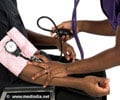Researchers say that pediatricians and nurses may be missing the development of hypertension and its serious consequences even when they read a child's blood pressure.

Even a single episode of high BP can indicate hypertension and should trigger repeat measurements during the visit and subsequent doctor visits, the AAP says.
The problem is that measuring a child's BP is far more complicated than it is in adults and requires interpreting each individual measure against a reference table for age, gender and height, says lead author Tammy Brady, nephrologist at Hopkins Children's Hospital in the US.
Researchers at Hopkins analysed 2,500 records of visits to the pediatrician's office. Medical staff did not check BP in 500 cases.
Elevated BP scores were recorded in 726 cases of the 2,000 measurements taken, but the implications went unrecognized and unremarked upon in 87 percent of them, the study found.
The findings underscore the need for better recognition and aggressive monitoring of all children to prevent both the short-term and long-term complications of hypertension, the investigators say.
Advertisement
The same was true for those children whose blood pressure was at or below 120/80, a score considered ideal in adults, but one that may portend trouble in a child, depending on height, gender and age, said a Johns Hopkins release.
Advertisement
The results of the study were published in Pediatrics.
Source-ANI
SRM









